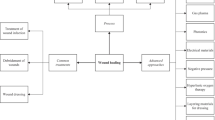Abstract
The inception of Physical, Electromagnetic and Biologic devices into the field of wound management has greatly changed the standard approach to wound healing—only think of negative pressure wound therapy. This and other innovations introduced a completely different approach both on diagnostic and therapeutic aspects of this multi-specialistic area, in a variety of conditions all characterized by chronic ulceration. The number and variety of medical devices focused on wound management would deserve a thorough evaluation and description, which is beyond the scope of this report, in which a synthesis of the more relevant among the new technologies applied so far in the clinical field, reporting also their level of evidence, addressing the reader to the relevant literature.
Access this chapter
Tax calculation will be finalised at checkout
Purchases are for personal use only
Similar content being viewed by others
References
Anghel EL, Falola RA, Kim PJ. Fluorescence technology for point of care wound management. Surg Technol Int. 2016;28:58–64. PMID: 27175815.
Beckman JA, Schneider PA, Conte MS. Advances in revascularization for peripheral artery disease: revascularization in PAD. Circ Res. 2021;128(12):1885–912.
Busch A, Jäger M, Mayer C, Sowislok A. Functionalization of synthetic bone substitutes. Int J Mol Sci. 2021;22(9):4412.
Campana V, Milano G, Pagano E, Barba M, Cicione C, Salonna G, Lattanzi W, Logroscino G. Bone substitutes in orthopaedic surgery: from basic science to clinical practice. J Mater Sci Mater Med. 2014;25(10):2445–61.
Casey G. Wound repair: advanced dressing materials. Nurs Stand. 2002;17(4):49–53; quiz 54, 56.
Dai C, Shih S, Khachemoune A. Skin substitutes for acute and chronic wound healing: an updated review. J Dermatolog Treat. 2020;31(6):639–48.
Ennis WJ, Lee C, Gellada K, Corbiere TF, Koh TJ. Advanced technologies to improve wound healing: electrical stimulation, vibration therapy, and ultrasound-what is the evidence? Plast Reconstr Surg. 2016;138(3 Suppl):94S–104S.
Fillingham Y, Jacobs J. Bone grafts and their substitutes. Bone Joint J. 2016;98-B(1 Suppl A):6–9.
Goodarzi P, Falahzadeh K, Nematizadeh M, Farazandeh P, Payab M, Larijani B, Tayanloo Beik A, Arjmand B. Tissue engineered skin substitutes. Adv Exp Med Biol. 2018;1107:143–88.
Iacopi E, Pieruzzi L, Goretti C, Piaggesi A. Pilot experience on the use of S53P4 bioactive glass in the surgical management of diabetic foot osteomyelitis. Int J Low Extrem Wounds. 2022;21(1):57–64.
Límová M. Active wound coverings: bioengineered skin and dermal substitutes. Surg Clin North Am. 2010;90(6):1237–55.
Lindholm C, Searle R. Wound management for the 21st century: combining effectiveness and efficiency. Int Wound J. 2016;13 Suppl 2(Suppl 2):5–15.
Luo GX, Wu J. Modern functional materials for promoting cutaneous wound healing. Zhonghua Shao Shang Za Zhi. 2020;36(12):1113–6.
Mani R, Margolis DJ, Shukla V, Akita S, Lazarides M, Piaggesi A, Falanga V, Teot L, **e T, Bing FX, Romanelli M, Attinger C, Han CM, Lu S, Meaume S, Xu Z, Viswanathan V. Optimizing technology use for chronic lower-extremity wound healing: a consensus document. Int J Low Extrem Wounds. 2016;15(2):102–19.
Piaggesi A, Låuchli S, Bassetto F, Biedermann T, Marques A, Najafi B, Palla I, Scarpa C, Seimetz D, Triulzi I, Turchetti G, Vaggelas A. Advanced therapies in wound management: cell and tissue based therapies, physical and bio-physical therapies smart and IT based technologies. J Wound Care. 2018;27(Sup6a):S1–137.
Piaggesi A, Bassetto F, Becquemin JP, Dalla Paola L, Den Braber E, Marques A, Raspovic K, Scarpa C, Turchetti G, Teot L. New technologies for tissue replacement. J Wound Manag (JOWM). 2022; In press.
Pieruzzi L, Napoli V, Goretti C, Adami D, Iacopi E, Cicorelli A, Piaggesi A. Ultrasound in the modern management of the diabetic foot syndrome: a multipurpose versatile toolkit. Int J Low Extrem Wounds. 2020;19(4):315–33. https://doi.org/10.1177/1534734620948351. Epub 2020 Aug 21. PMID: 32820699.
Rayman G, Vas P, Dhatariya K, Driver V, Hartemann A, Londahl M, Piaggesi A, Apelqvist J, Attinger C, Game F. International Working Group on the Diabetic Foot (IWGDF). Guidelines on use of interventions to enhance healing of chronic foot ulcers in diabetes (IWGDF 2019 update). Diab Metab Res Rev. 2020;36 Suppl 1:e3283.
Rogers JH, Laird JR. Overview of new technologies for lower extremity revascularization. Circulation. 2007;116(18):2072–85.
Rudge T. Situating wound management: technoscience, dressings and “other” skins. Nurs Inq. 1999;6(3):167–77.
Author information
Authors and Affiliations
Corresponding author
Editor information
Editors and Affiliations
Rights and permissions
Copyright information
© 2023 The Author(s), under exclusive license to Springer Nature Switzerland AG
About this chapter
Cite this chapter
Piaggesi, A. (2023). Physical, Electromagnetic, Biologic Devices. In: Mani, R. (eds) Chronic Wound Management. Springer, Cham. https://doi.org/10.1007/978-3-031-26110-7_6
Download citation
DOI: https://doi.org/10.1007/978-3-031-26110-7_6
Published:
Publisher Name: Springer, Cham
Print ISBN: 978-3-031-26109-1
Online ISBN: 978-3-031-26110-7
eBook Packages: MedicineMedicine (R0)




